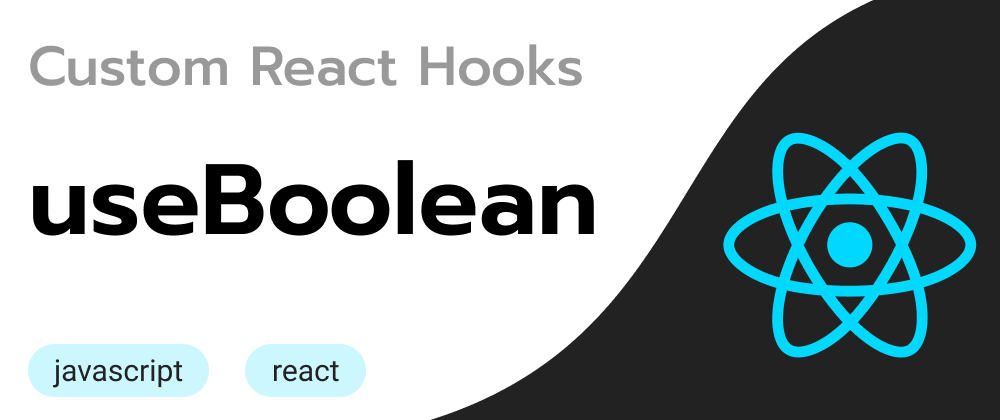React hooks initially allow you to "hook into" React state and lifecycle features, like we used to do with the componentDidMount or componentWillUnmount methods when using class based components. What we'll discover in this article is that we can implement our own custom hooks, using the few primitives hooks React provides us, like useState and useEffect. This way, you can drastically reduce the cognitive complexity of your components, by moving away some logic into functions that you will be able to reuse anywhere in the other components of your React applications. Your code will look cleaner, and you're following the Single Responsibility Principle (SRP), which states that each class or function (or, in our case, component) should have responsibility over a single part of a program's functionality, and it should encapsulate that part.
Enough talk, let's get to work and implement our first custom hook: useBoolean! 😎
Motivation
First of all, why are we going to implement such a hook? Let's have a look at this simple component:
const Spoil = ({ content }) => {
const [showSpoil, setShowSpoil] = useState(false);
return (
<div className="spoil">
<button onClick={() => setShowSpoil((visible) => !visible)}>
{showSpoil ? "Hide" : "Show"}
</button>
{showSpoil && <div className="spoil-content">{content}</div>}
</div>
);
};
The component receives a content prop, that only appears once the button gets clicked to show the spoil. Of course, clicking the button again will hide it back, and so on.
Here, the component is so simple that it is very easy to read, but we could improve its readability by extracting the button onClick listener to a separate function:
const Spoil = ({ content }) => {
const [showSpoil, setShowSpoil] = useState(false);
const toggle = () => setShowSpoil((visible) => !visible)
return (
<div className="spoil">
<button onClick={toggle}>
{showSpoil ? "Hide" : "Show"}
</button>
{showSpoil && <div className="spoil-content">{content}</div>}
</div>
);
};
That's better. We've simplified the return value of our function, but we've added a new line between the state initialization and the return statement. Of course this is not a major problem in our case, but when dealing with more complex components, this can lead to redundant functions declarations.
In fact, our component could be further simplified if we had a useBoolean hook, that we would use like this:
const Spoil = ({ content }) => {
const [showSpoil, setShowSpoil] = useBoolean(false);
return (
<div className="spoil">
<button onClick={setShowSpoil.toggle}>
{showSpoil ? "Hide" : "Show"}
</button>
{showSpoil && <div className="spoil-content">{content}</div>}
</div>
);
};
See? We didn't add any extra function, and the onClick listener is easier to read. Now, let's move into the implement of this simple hook, shall we? 😎
Implementation
First, we define a function in which we can use the useState hook.
const useBoolean = (initialValue) => {
const [value, setValue] = useState(initialValue)
return [value, setValue]
}
⚠️ Be careful: you'll only be able to use the
useBooleanfunction (or should I say hook) in React components, as it uses theuseStatehook.
So far, we've just created an alias for the useState hook.
Not very useful...😅
The interesting part comes now: instead of having the setValue function in the return array, we will use an object that will contain 3 methods:
-
toggle()to toggle the value -
on()to set the value totrue -
off()to set the value tofalse
Our hook now looks like this:
const useBoolean = (initialValue) => {
const [value, setValue] = useState(initialValue)
const updateValue = useRef({
toggle: () => setValue(oldValue => !oldValue),
on: () => setValue(true),
off: () => setValue(false)
})
return [value, updateValue.current]
}
And here it is, you've just created your first custom hook, congratulations! 🥳
Usage
const Articles = () => {
const [articles, setArticles] = useState([])
const [isLoading, setIsLoading] = useBoolean(false)
const [isError, setIsError] = useBoolean(false)
useEffect(() => {
setIsLoading.on()
fetch(...)
.then(res => res.json())
.then(setArticles)
.catch(setIsError.on)
.finally(setIsLoading.off)
}, [])
return ...
}
⚠️ Be careful: you can't use
setIsLoading(true)as we don't export a function anymore but an object.
See how the above snippet is very easy to read? 😎
Conclusion
Thanks for reading me. I hope you enjoyed this article, and if that's the case, don't hesitate to have a look at my other ones. Also, feel free to post some comments if you have any questions, or if you just want to say "hi". 👋
Support Me
If you wish to support me, you can buy me a coffee with the following link (I will then probably turn that coffee into a new custom hook... ☕)
References
https://reactjs.org/docs/hooks-overview.html
https://en.wikipedia.org/wiki/Single-responsibility_principle




















